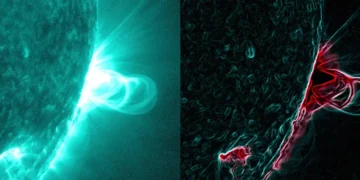In September 1859, the Carrington event—a powerful solar storm—caused widespread disruption to the telegraph systems across Europe and North America, even sparking fires. This event served as a stark warning of what could happen when our planet is hit by a severe solar storm. Fast forward to today, and new research suggests that the Carrington event might pale compared to some of the extreme solar storms that have battered Earth in the past.
What Are Extreme Solar Storms?
Extreme solar storms are powerful disturbances caused by intense solar activity, particularly coronal mass ejections (CMEs) and solar flares. These events can eject vast amounts of charged particles into space, which, when directed towards Earth, can disrupt our planet’s magnetosphere. A classic example is the Carrington event, where a massive CME sent charged particles crashing into Earth’s magnetic shield, leading to widespread auroras and telegraph malfunctions.
Recent studies have shown that these solar storms are not rare occurrences limited to the past. Evidence from tree rings and ice cores suggests that more severe events have occurred, potentially causing greater havoc than the storms we’ve witnessed in documented history. This raises the question: are we prepared for when—not if—the next major solar storm hits?
Researchers have found that past extreme solar storms leave behind distinct signatures in tree rings, particularly in the form of elevated levels of radiocarbon, or carbon-14. By analyzing these rings, scientists can pinpoint the exact year when a storm occurred, providing a historical record of solar activity. For example, the AD 774 storm was detected through a sudden spike in radiocarbon found in tree rings, suggesting it was far more powerful than the Carrington event.
A more recent study published in Nature identified an even older event that took place around 14,370 years ago, marking the most extreme solar storm ever recorded. Such findings are critical because they provide insight into the frequency and scale of solar storms, challenging the previous assumption that the Carrington event was a one-time anomaly.
Potential Impacts on Modern Technology
If an extreme solar storm were to occur today, the consequences could be catastrophic for our modern, technology-based society. The most immediate threat comes from the potential damage to satellites, power grids, and communication networks. A powerful solar storm can induce electric currents in power lines, leading to blackouts that could last days or even weeks. In 1989, a much smaller storm than the Carrington event knocked out power in Quebec, Canada, affecting millions of people.
Imagine a scenario where a storm similar to the one detected in AD 774 were to strike. Our reliance on technology makes us far more vulnerable today than in the 19th century. Satellites that control everything from GPS navigation to weather forecasting could be knocked offline, and communication networks could be severely disrupted, leading to widespread chaos.
Understanding the Frequency and Scale of Solar Storms
The new evidence of extreme solar storms from the radiocarbon record allows scientists to estimate how often these events might occur. This is crucial for forecasting and preparing for future storms. The recurrence interval of such massive storms seems to be in the range of several hundred to a few thousand years, but this does not mean we are safe in the short term.
There’s an ongoing debate among scientists about whether these storms are simply larger versions of regular solar activity or if they are caused by distinct, rare physical phenomena. Understanding this distinction could help us predict the likelihood of future events and improve our preparedness.
The Science Behind Radiocarbon Analysis and Dendrochronology
Radiocarbon dating has been a critical tool for archaeologists and geologists for decades, but its application in studying solar storms is a relatively new and exciting development. Radiocarbon is formed in the atmosphere when cosmic rays collide with nitrogen atoms, creating carbon-14, which then gets absorbed by living organisms, including trees. By measuring the radiocarbon levels in tree rings, scientists can identify periods of intense cosmic radiation, which often coincide with extreme solar storms.
Dendrochronology, or the study of tree rings, provides precise dating of these events. When combined with radiocarbon analysis, it allows researchers to pinpoint the exact year of a storm, providing a clear timeline of solar activity. This method has revealed a pattern of extreme solar storms over the past 10,000 years, highlighting the ongoing threat they pose to Earth.
Why This Research Matters for the Future
Understanding extreme solar storms is not just about improving our knowledge of the past; it’s about preparing for the future. The evidence of these storms provides valuable data that can improve the accuracy of radiocarbon dating and help us better understand the dynamics of our Sun. More importantly, it underscores the need for robust forecasting systems and contingency plans to protect our infrastructure.
Ongoing research aims to identify even more ancient solar storms by analyzing older trees from various parts of the world. By building a comprehensive record of these events, scientists hope to develop better models to predict when the next storm might occur. This could lead to improved early warning systems, allowing governments and industries to take proactive measures to protect power grids, satellites, and other critical infrastructure.
The Path Forward: Preparing for the Inevitable
While it’s impossible to prevent solar storms, being forewarned is being forearmed. The scientific community is racing against time to understand these events better and find ways to mitigate their impact. Enhanced monitoring of the Sun’s activity, coupled with improved data from radiocarbon dating, could be our best defense against future disasters.
Governments and industries must take these findings seriously and invest in shielding vulnerable systems against electromagnetic pulses and solar radiation. This includes hardening satellites, reinforcing power grids, and developing protocols for rapid response during solar storm warnings.
Reference:
https://www.nasa.gov/mission_pages/sunearth/spaceweather/index.html



















